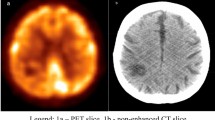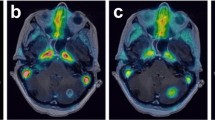Abstract
Pentavalent technetium-99m dimercaptosuccinic acid (Tc-99m (V) DMSA) is reported as a useful tool for detection of residual or recurrent gliomas. We aimed to investigate the prognostic value of Tc-99m (V) DMSA brain SPECT in patients with glioblastoma multiforme (GBM). 40 patients [21 males and 19 females; mean age 48.6 ± 12.2 years] with GBM were included. Tc-99m (V) DMSA brain SPECT was done after surgery and before onset of radiation therapy or chemotherapy (Baseline study), at 4–6 weeks and at 6 months as a follow-up after therapy. The end point of the study was clinical follow-up for 2 years and/or death. 4–6 weeks after therapy, 40 and 60 % had negative and positive Tc-99m (V) DMSA for viable tumor tissues respectively (P = 0.09). At 6 months follow-up, 62.5 % of (V) DMSA negative patients and 12.5 % of the positive subjects were responders (P = 0.001). The median over-all survival (OS) of all patients was 12.3 month [range 5–24 month]. Patients with positive (V) DMSA had worse survival (8.87 month) compared to the negative ones (16.67 month) (P = 0.0001). Multivariate Cox regression analysis showed that Tc-99m (V) DMSA brain SPECT studies at 4–6 weeks and 6-months follow-up were independent prognostic factors for survival [OR 1.069; 95 % CI 1.417–2.174; P = 0.03 and OR 1.055; 95 % CI 0.821–1.186; P = 0.01 respectively]. Stratification of tumors into risk groups based on prognostic parameters may improve outcome by altering or intensifying treatment methods. Technetium-99m dimercaptosuccinic acid brain SPECT may have an additional prognostic role in patients with GBM which needs further evaluation in larger future series.



Similar content being viewed by others
References
Stupp R, Mason WP, van den Bent MJ, Weller M, Fisher B, Taphoorn MJ et al (2005) Radiotherapy plus concomitant and adjuvant temozolomide for glioblastoma. N Engl J Med 10(352):987–996
Scott JN, Rewcastle NB, Brasher PM et al (1999) Which glioblastoma multiforme patient will become a long-term survivor? A population-based study. Ann Neurol 46:183–188
Liu Y, Shete S, Etzel CJ et al (2010) Polymorphisms of LIG4, BTBD2, HMGA2, and RTEL1 genes involved in the double-strand break repair pathway predict glioblastoma survival. J Clin Oncol 28:2467–2474
Curran WJ Jr, Scott JB, Horton J et al (1993) Recursive partitioning analysis of prognostic factors in three Radiation Therapy Oncology Group malignant glioma trials. J Natl Cancer Inst 85:690–691
Lacroix M, Abi-Said D, Fourney DR et al (2001) A multivariate analysis of 416 patients with glioblastoma multiforme: prognosis, extent of resection, and survival. J Neurosurg 95:190–198
Shinojima N, Kochi M, Hamada J et al (2004) The influence of sex and the presence of giant cells on postoperative long-term survival in adult patients with supra-tentorial glioblastoma multiforme. J Neurosurg 101:219–226
McLendon R, Friedman A, Bigner D et al (2008) Comprehensive genomic characterization defines human glioblastoma genes and core pathways. Nature 455:1061–1068
Amin A, Moustafa H, Ahmed E, El-Toukhy M (2012) Glioma residual or recurrence versus radiation necrosis: accuracy of pentavalent technetium-99m-dimercaptosuccinic acid [Tc-99m (V) DMSA] brain SPECT compared to proton magnetic resonance spectroscopy (1H-MRS): initial results. J Neurooncol 106:579–587
Alexiou GA, Tsiouris S, Kyritsis AP, Fotakopoulos G, Goussia A, Voulgaris S, Fotopoulos AD (2010) The value of 99mTc-tetrofosmin brain SPECT in predicting survival in patients with glioblastoma multiforme. J Nucl Med 51:1923–1926
Denoyer D, Perek N, Le Jeune N, Frere D, Dubois F (2004) Evidence that 99mTc-(V)-DMSA uptake is mediated by NaPi cotransporter type III in tumour cell lines. Eur J Nucl Med Mol Imaging 31:77–84
Denoyer D, Perek N, Le Jeune N, Cornillon J, Dubois F (2005) Correlation between 99mTc-(V)-DMSA uptake and constitutive level of phosphorylated focal adhesion kinase in an in vitro model of cancer cell lines. Eur J Nucl Med Mol Imaging 32:820–827
Tsiouris S, Pirmettis I, Chatzipanagiotou T, Ptohis N, Papantoniou V (2007) Pentavalent technetium-99m dimercaptosuccinic acid 99mTc-(V) DMSA brain scintitomography a plausible non-invasive depicter of glioblastoma proliferation and therapy response. J Neurooncol 85:291–295
Hirano T, Tomiyoshi K, Zhang YJ, Ishida T, Inoue T, Endo K (1994) Preparation and clinical evaluation of 99mTc-DMSA for tumor scintigraphy. Eur J Nucl Med 21:82–85
Henze M, Mohammed A, Schlemmer HP, Herfarth KK, Hoffner S, Haufe S, Mier W, Eisenhut M, Debus J, Haberkorn U (2004) PET and SPECT for detection of tumor progression in irradiated low-grade astrocytoma: a receiver-operating-characteristic analysis. J Nucl Med 45:579–586
Deltuva V, Bunevicius A, Jurkiene N, Kulakiene I, Tamasauskas A (2012) Perioperative single photon emission computed tomography in predicting survival of malignant glioma patients. Oncol Lett 4:739–744
Byrne TN (1994) Imaging of gliomas. Semin Oncol 21:162–171
Chen W (2007) Clinical applications of PET in brain tumors. J Nucl Med 48:1468–1481
Benard F, Romsa J, Hustinx R (2002) Imaging gliomas with positron emission tomography and single-photon emission computed tomography. Semin Nucl Med 33:148–162
Soler C, Beauchesne P, Maatougui K, Schmitt T, Barral FG, Michel D, Dubois F, Brunon J (1998) Technetium-99m sestamibi brain single-photon emission tomography for detection of recurrent gliomas after radiation therapy. Eur J Nucl Med 25:1649–1657
Hirano T, Otake H, Kazama K, Wakabayashi K, Zama A, Shibasaki T, Tamura M, Endo K (1997) Technetium-99m (V)-DMSA and thallium-201 in brain tumor imaging: correlation with histology and malignant grade. J Nucl Med 38:1741–1749
Yoshii Y, Satou M, Yamamoto T, Yamada Y, Hyodo A, Nose T, Ishikawa H, Hatakeyama R (1993) The role of thallium-201 single photon emission tomography in the investigation and characterisation of brain tumours in man and their response to treatment. Eur J Nucl Med 20:39–45
Semba T, Sugawara Y, Ochi T, Fujii T, Mochizuki T, Ohnishi T (2006) Thallium-201 SPECT in prognostic assessment of malignant gliomas treated with postoperative radiotherapy. Ann Nucl Med 20:287–294
Kosuda S, Fujii H, Aoki S, Suzuki K, Tanaka Y, Nakamura O, Shitara N (1994) Prediction of survival in patients with suspected recurrent cerebral tumors by quantitative thallium-201 single photon emission computed tomography. Int J Radiat Oncol Biol Phys 30:1201–1206
Vos MJ, Berkhof J, Hoekstra OS, Bosma I, Sizoo EM, Heimans JJ, Reijneveld JC, Sanchez E, Lagerwaard FJ, Buter J, Noske DP, Postma TJ (2012) MRI and thallium-201 SPECT in the prediction of survival in glioma. Neuroradiology 54:539–546
Costa BM, Caeiro C, Guimarães I et al (2010) Prognostic value of MGMT promoter methylation in glioblastoma patients treated with temozolomide-based chemoradiation: a Portuguese multicentre study. Oncol Rep 23:1655–1662
Acknowledgments
The authors thank Dr. Zeinab Nawito and Medical student Mariam Amr for helpful contributions in the finalization of this work regarding grammatical aspects.
Conflict of interest
None.
Author information
Authors and Affiliations
Corresponding author
Rights and permissions
About this article
Cite this article
Amin, A., Mustafa, M., Abd El-Hadi, E. et al. Pentavalent technetium-99m-dimercaptosuccinic acid [Tc-99m (V) DMSA] brain SPECT: does it have a place in predicting survival in patients with glioblastoma multiforme?. J Neurooncol 121, 303–309 (2015). https://doi.org/10.1007/s11060-014-1633-9
Received:
Accepted:
Published:
Issue Date:
DOI: https://doi.org/10.1007/s11060-014-1633-9




